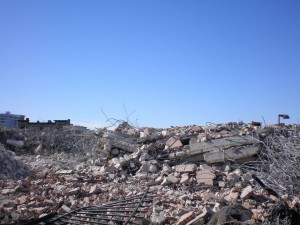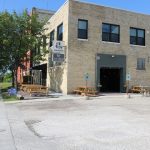Demolish Part of Downtown Milwaukee? No.

Demolition
Recently, it was reported that Robert and Michael Levine are once again considering the demolition of historic buildings along Wisconsin Ave. and Milwaukee St., this time with the hope of landing a hotel development. The proposal draws upon the failed “urban renewal” projects of the past. Bulldoze the heart of the city, level the past, and then try, one day, to build new. Unfortunately, the most common results of which are new surface parking lots, a loss of city character, and (if we’re lucky) sterile, suburban-style development, not high-quality, urban infill development.
This plan is especially disturbing as there are great models of what can be done with historic structures, literally all around this block. In the Historic Third Ward, an entire neighborhood has grown up by investing in aging structures and mixing in new development, not by mass demolition. Just down Milwaukee St. from this site, Milwaukee’s high-end entertainment district is a direct result of the restoration and re-use of historic structures. In view of the buildings that are to be torn down, there are now plans to renovate the historic Loyalty building and convert it into a hotel. Not too far from downtown, the Iron Horse Hotel, which was recently named the “Boutique Hotel of the Year” 2010 by the Boutique & Lifestyle Lodging Association, is a fine example of rehabilitating and re-purposing a decaying structure.
There may come a day when tearing down portions of the Milwaukee’s core to build new is advised, but no, today is not that day.
UPDATE: If this project were to go forward it would be Wave Development, LLC, as the developer. Robert and Michael Levine would sell the Broadway Books and Starbar buildings to Jackson Street Management, LLC which would tear them down, and other buildings, to build the hotel. Further, this project would demolish buildings on Wisconsin Ave., and Milwaukee St., not Broadway. A related project, involving some of the same property owners, would demolish building(s) on Broadway. All of this area is in a Historically designated district.






















If the they can land another big modern project like hotel or office building that will look like a 21st century establishment I say tear it up. These old building will have to go one day or other. They are getting to old to sustain and sometimes renovations are so expansive that it makes sense just to build a new one. You cant compare how old renovated building would look like compare to the new glass and steel or other material colorful building of today.
Agreed Dave. And I’d argue, if the new hotel construction bar is set at the Aloft or Staybridge level, all the more reason to preserve this historic cluster. Those are two characterless buildings.
Adaptive reuse would allow this particular hotel the chance to differentiate, much like the Iron Horse or Hotel Metro. Don’t blow that opportunity for the sake of saving money. The city becomes a better place when people take chances on doing something unique.
@Chris Yeah saving these buildings could allow for a great, unique place. While a new build will almost certainly be characterless.
I’m all for saving historic buildings when it makes sense–Milwaukee’s downtown is fairly unique among large cities because so much of its Victorian-era architecture has been saved. That said, buildings shouldn’t be saved just because they’re old; if all of the circa 1870 buildings had been saved, downtown would look like Racine. There’s an argument to be made for ‘renewal” when the current buildings are not architecturally significant, or when they stand out from what else is there. Yes, the buildings are near the Loyalty (ironic that a hotel might go up on the site of the Newhall Hotel, which burned to the ground and killed 71), but some of them front the city’s principal thoroughfare, Wisconsin Avenue, which is dominated by taller structures. These much smaller buildings are out of place.
I haven’t lived in Milwaukee for two years (plan to move back in February!) but from what I remember, this is kind of a dead area in the evenings and on the weekends. I’m all for saving historic buildings, but there is something to be said for getting people downtown… and a hotel would do that (or two hotels if the nearby Loyalty Building is going to be converted into a hotel).
I’m wondering though… the article indicates the land would be cleared for a possible hotel development. Why does the land have to be cleared before a hotel would consider building there? It obviously seems silly to tear down buildings before knowing what they would be replaced with. This can’t be be how things are generally done in the development world… or is it?
Oh, I just checked this area out on Google Street View, and I believe the historic buildings in question can be seen on Urban Milwaukee’s former ‘street car’ rendering here:
http://urbanmilwaukee.com/2010/05/06/milwaukee-streetcar-takes-key-step-forward/
The historic buildings look pretty nice in the rendering next to the street car stop… but it seems that in the rendering, the historic Grain Exchange building has been replaced with a tall glass building, haha, is it ok to tear down the Grain Exchange and replace it with something more modern?
Hey Michael James, as for the Grain Exchange there is a huge parking lot just south of it. I would assume any renderings you saw were assuming that parking lot was developed and not the actual footprint of the Grain Exchange.
No way should these buildings be torn down. “Character” is the perfect word to describe what would be lost with a new hotel development. These buildings provide a great contrast to other buildings in the area as well as being part of Milwaukee’s past. Some of the best cities in the world I’ve visited have been great in my mind because of the amazing architecture that has been preserved. Is there really no other sites in the city that couldn’t support a hotel development? If you think the answer is no…I’m sorry but your full of it. I’d need some weird hand mutation to be able to count the number of surface lots in the downtown area on my fingers, and while some of them aren’t in an ideal location for a hotel…others definitely are.
Stop the thinking of “new is always better”. At a bare minimum the facades should be saved.
@Michael James Not far, maybe 10 blocks, from this site is a big hole in the ground. What happened? Oh a developer was going to build condos or apartments. So the demolished a building and the project fell apart. And this happened before the recession.
@Jesse Yes I believe you are correct.
The old Republican Hotel (birthplace of baseball’s American League), now the Journal Sentinel’s parking lot.
The Industrial Exposition Building, now the Milwaukee Theater (could be seen as a fair trade-off).
The old Milwaukee Road Depot, now the soulless modern box that houses WE Energies (This may very well be Milwaukee’s biggest architectural mistake ever, and I LIKE modern architecture. To destroy such a beautiful building and to be replaced with that is bordering on sacrilege). These were part of Milwaukee’s heritage and were works of art in their own right. Now, gone forever.
These old, beautiful, ornate, sculpted buildings will not be made anymore. The amount of decor, the skill it takes to sculpt facades, and the labor intensiveness of building ornamentation simply costs far too much today and will only be done in very very rare instances. Tearing down only creates holes in our city fabric.
We don’t have the resources to build it all anew. Build within and around that which already exists. Improving. Complimenting. Lest we tear down every memory of a gilded past, forget where this city has been, so we don’t know where we’re moving towards.
@Paul Yes that is precisely how I feel about it.
Sorry all, looks like I was wrong about the ‘streetcar rendering.’
Out of curiosity though, what’s the latest word on the streetcar?
@Michael JamesI I believe DPW is working on the engineering, the RFI went out this summer for streetcar manufacturers, and so things are moving along.
Character. It’s apparently the greatest (and only) defense for saving old downtown buildings. They add something to the street and the the continuity of the urban fabric. Or something.
But before we use character as a cop out for refusing to modernize, we may want to take a look at what “character” has done for E Wisconsin Avenue. Buildings from the 1800s and early twentieth sit vacant, stunted, and burned out. Successful shops and offices refuse to occupy these buildings, and they provide absolutely no contribution to pedestrian activities, aside from wandering into the book store or Ethiopian restaurant.
Their height is uncharacteristically short for a main downtown avenue. Blocks of buildings no more than four stories tall make skyline-forming giants like the US Bank and the von Briesen building seem isolated and out of place. The color palette of historic buildings on Wisconsin Avenue is akin to that of urine or beer, and the materials are old and poorly maintained.
This “character” has scared off new high-rise developments of clean glass and steel for years, leaving Wisconsin Avenue with a depressing row of dying small businesses, a failed mall, and wasted potential. Just because a building is old does not make it sacred. Just because a building has a facade does not mean it’s beautiful. Just because these buildings have always been there does not mean that there will be nothing to replace them.
It’s time downtown Milwaukee began to let go of its past lest it keep on detracting all new development.
@Brent
“Successful shops and offices refuse to occupy these buildings, and they provide absolutely no contribution to pedestrian activities, aside from wandering into the book store or Ethiopian restaurant.”
Of course there are extremely successful examples of rehabbed buildings right around the corner, it just took a little effort, which these buildings clearly haven’t seen in years.
“This “character” has scared off new high-rise developments of clean glass and steel for years, ”
Huh? Or maybe there isn’t enough demand for a new high-rise?
“It’s time downtown Milwaukee began to let go of its past lest it keep on detracting all new development.”
Certainly new development in downtown Milwaukee is desirable and more often than not encouraged here at UrbanMilwaukee.com, but to tear down these buildings to do it, is simple not good for Milwaukee, as we’ll be loosing more than we gain.
This is the mentality that lost us a part of the Pabst mansion. It is also the mentality of throw-away everything and buy a new one. If we dont care to maintain what we have, why would we take care of something new, and if we’re not going to take care of it, why build something nice. Lets just bulldoze it all and build a series of walmarts and sub divisions.
Having lived away for 17-years, I am excited to be moving back to raise my children in a few years. One of the things I look forward to sharing with my kids is the history of the city and the diversity of our neighborhoods. If I’m not mistaken, there are several walking tours offered throughout the city. When you point to an old building, there is typically a story behind it (often fascinating): When it was built, the style of architecture at the time, the architect, the demographics of the city at the time it was built, the connections to modern-day Milwaukee (i.e., Pritzlaf building), etc. I would hate to lose that. I want to teach them that Milwaukee has an amazing history and use those buildings as a back drop to tell that story. These buildings tell that story, connect us to an amazing past, and yes, give the city character.
Milwaukee needs to seize the blighted properties of the tasteless, greedy Boris Gokhman, Bob Levine, and their ilk, and allow the properties to be developed by people who have a sense of history, culture, aesthetics, architecture and civic pride.
Buildings will be renovated or developed once there are people coming downtown and making demands on downtown commerce. Erecting buildings without providing for easy movement into and out of downtown is not going to change anyone’s mind about coming into downtown. What downtown needs is modern transportation, particularly streetcars – the kind of public transportation that is universally loved. Development follows the tracks.
That Business Times article is a good laugh. “I’m an office developer, not a hotel developer.” Really, Michael? How many offices have you developed? Name one.
We have always lived in slums and holes in the wall. We will know how to accommodate ourselves for a while. For, you must not forget, we also know how to build. It is we the workers who built these palaces and cities, here in Spain and in America, and everywhere. We, the workers, can build others to take their place, and better ones! We are not in the least afraid of ruins. We are going to inherit the earth – there is not the slightest doubt about that. The hiring class might blast and ruin its own world before it leaves the stage of history. We carry a new world, here, in our hearts. That world is growing this minute.